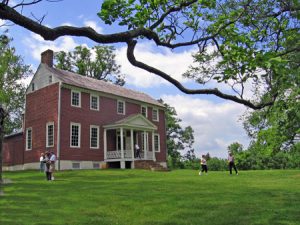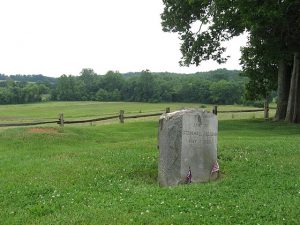For more than two hundred years, this Spotsylvania farm has stood as a witness to Virginia history. Originally carved from land given to colonial Governor Alexander Spotswood, Ellwood willingly hosted two armies-that of the Marquis de Lafayette during the Revolutionary War and General Robert E. Lee during the Battle of Chancellorsville in 1863. However, in 1864, during the Battle of the Wilderness, Ellwood became the headquarters for Generals Gouverneur K. Warren and Ambrose E. Burnside. General Grant took his position a few hundred yards away from the house, at a spot still called Grant's Knoll.
Ellwood's Beginnings
In the years just before the American Revolution, two brothers named William and Churchill Jones came to settle out in the Wilderness. Churchill eagerly joined the Army and became Major of a regiment that belonged to the Southern Legion, commanded by "Light Horse Harry," the father of General Robert E. Lee.
William, not afire for the patriotic cause, stayed at home and farmed. But, when his brother's comrade-in-arms came to pay a call, complete with pitched tents, William Jones was most hospitable:
"A small knoll exists just north of Ellwood, perfect for observation by commanding officers. And it was here, in 1781, that Major General Lafayette would pitch his headquarters tent. While awaiting reinforcements from Mad Anthony Wayne, on their way to Yorktown, the Marquis' horses consumed a field of timothy, and yet, Jones supplied the troops with 700 pounds of beef. Lafayette never forgot the kindness, and breakfasted with him at Ellwood during his 1824-25 grand tour of the United States."
--American Revolutionary War Round Table newsletter, June 2005
In the years following the Revolution, William and Churchill went about building homesteads in the Wilderness area. William and his first wife built Ellwood in the 1790s. Churchill built nearby Woodville, but he would acquire William Fitzhugh's grand Falmouth mansion, Chatham, in 1806.
Major Churchill Jones and "Light Horse Harry" were devoted friends. In the decades after the Revolutionary War, when Lee fell on hard times, he stayed at Ellwood, where, according to family tradition, he wrote his wartime memoirs.
A May-December Wedding
In 1828, five years after losing his first wife, 78-year-old William Jones married his former spouse's grandniece, Lucinda Gordon. She was 16 years old. William and his young bride had a daughter, whom he named Betty Churchill, after his first wife. According to daughter Betty, William Jones wore old-fashioned knee britches and ruffles until the day he died.
When William passed on in 1845 at the age of 95, he left Ellwood to Lucinda on the condition that she would never remarry. However, within two years, Lucinda gave up Ellwood to her daughter so that she might marry John Strother Green of Culpeper.
"The Lacy House"
Chatham may be the more famous property owned by the Lacy family, but Ellwood was the original estate. It was here that Betty Churchill Jones, William's daughter, married J. Horace Lacy, a handsome tutor of modest background on October 19, 1848. He had been teaching at the home of her cousins, Eagle Point in Gloucester County. Nine years later, they purchased the grand estate of Chatham. Chatham had been owned by Hannah Jones Coulter, Betty's half-sister who happened to be 49 years the elder of the two.
When war was declared, J. Horace Lacy, called "the most dangerous rebel of the county," promptly joined the Confederate Army. While he was in battle, his family evacuated to Lexington and later Pulaski County.
"Stonewall" Jackson's Arm Interred at Ellwood
During the Battle of Chancellorsville, Ellwood was used as a makeshift Confederate hospital. Chancellorsville was to be a sound Confederate victory, but the wounding and ultimate loss of one of its most brilliant generals dealt a heavy blow to the South. As Thomas "Stonewall" Jackson was riding back to his lines in the darkness, friendly fire from a North Carolina troop caught the general in the arm. It was shattered beyond repair and was amputated at a field hospital, located at Wilderness Tavern, on May 3, 1863. Jackson was moved 27 miles by horse ambulance to Guinea (Guiney) Station. The plan was to move him to Richmond for recovery, but he contracted pneumonia and died six days later.
The normal method for disposing of severed limbs was cremation. However, in General Jackson's case, Reverend Beverly Tucker Lacy, chaplain of Jackson's Corps and J. Horace Lacy's brother, buried the arm in the Lacy family cemetery at Ellwood. The Jackson marker was added in 1903 by a former Jackson staff member, the Rev. James Power Smith. Today, there are no other tombstones standing in the Ellwood cemetery.
In 1921, a skeptical general named Smedley Butler had a squad of Marines dispatched to dig up the cemetery, to find traces of the arm. It was indeed found, and the Marines reburied it, this time in a box, and left behind a plaque marking the event.
1864: Behind Union Lines
"For three days in May 1864, during the Battle of the Wilderness, the eyes of the world focused on Ellwood and its surrounding fields and thickets. The grounds teemed with Union artillery and soldiers as they prepared for, or recovered from, intense fighting a mile to the west. General Ulysses S. Grant - recently appointed commander of all Union armies throughout the country - made his headquarters just a few hundred yards north of Ellwood. Generals Gouverneur K. Warren and Ambrose E. Burnside, two of the army's four corps commanders, moved into Ellwood itself. Orderlies and staff officers swarmed around the buildings, carrying orders to front-line troops. By battle's end, Ellwood's floors were stained with blood, its gardens trampled, its fences gone. Graves dotted the grounds. The house's caretakers had been arrested and sent to Old Capitol Prison in Washington. For the next eight years, Ellwood would stand vacant used only by occasional squatters."
--Fredericksburg and Spotsylvania National Military Park: Ellwood Manor
After the War
The Civil War so devastated grand Chatham that the estate had to be sold for taxes in 1872. However, the Lacy family held on to Ellwood for another 35 years, until it was finally sold upon Betty's death in 1907 to a law professor named Hugh Evander Willis. It remained in the Willis family until 1977 when it was willed to the National Park Service.
Visiting Ellwood Today
Since 1988, the Friends of Wilderness Battlefield, in partnership with the National Park Service, have tended the grounds and offered tours of Ellwood.
It is possible to visit the grounds almost any day, but first, stop by the Chancellorsville Visitor Center to sign in and get a parking pass.
Click here for a current schedule.
Additional Resources
In the Library
Archaeological Excavations at the Ellwood House Porch, Fredericksburg-Spotsylvania, Virginia by Ronald A. Thomas and Alexis J. Sieg.
Into the Wilderness With the Army of the Potomac
The Smoothbore Volley That Doomed the Confederacy
On the Web
The American Revolution in the South by Henry (Light Horse Harry) Lee. Edited, with a biography of his father, by Robert E. Lee.
Beyond the Arm
Local newspaper reporter Lee Woolf gives a rundown of Ellwood's history, including comments on the restoration efforts by a family member.
Fredericksburg and Spotsylvania National Military Park: Ellwood Manor
Includes a short history, a map of the grounds, and hours of operation.
Friends of Wilderness Battlefield: Ellwood Restoration
The Friends have been hugely successful in adopting the cause of Ellwood's ongoing restoration. FOWB members volunteer to educate the public about local Civil War battles through tours and programs in the community. This site has the best photos, both inside and outside, of Ellwood.
The "Letters to Doct. James Carmichael & Son" Online Exhibit
William Jones of Ellwood corresponded with Dr. Carmichael concerning the health of his family and his slaves. His letters may be viewed online.
Memories of a Long Life by Betty Churchill Lacy, April 1903
William Jones' daughter by his second wife shares her memories of growing up at Ellwood and Chatham.
Photograph of Ellwood adjacent to the lead paragraph comes from the National Park Service.



